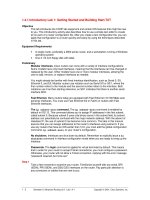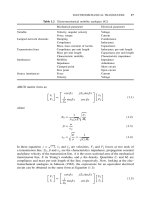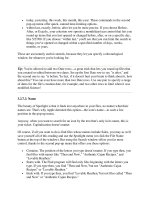Tài liệu The Save and Open Dialog Boxes pdf
Bạn đang xem bản rút gọn của tài liệu. Xem và tải ngay bản đầy đủ của tài liệu tại đây (22.97 KB, 5 trang )
5.8. The Save and Open Dialog Boxes
When you choose File Save, you're asked where you want the new document stored
on your hard drive. The resulting dialog box is crystal-clear—more than ever, it's a
miniature Finder. All of the skills you've picked up working at the desktop come into
play here.
To give it a try, launch any Mac OS X program that has a Save or Export command—
TextEdit, for example. Type a couple of words, and then choose File Save. The Save
sheet appears (Figure 5-15
).
Tip: In Mac OS X, a quick glance at the Close button in the upper-left corner of a
document window tells you whether it's been saved. When a small dot appears in the red
button, it means you've made changes to the document that you haven't saved yet. (Time
to press -S!). The dot disappears as soon as you save your work.
5.8.1. Sheets
In the days of operating systems gone by, the Save dialog box appeared dead center on
the screen, where it commandeered your entire operation. Moreover, because it seemed
stuck to your screen rather than to a particular document, you couldn't actually tell which
document you were saving—a real problem when you quit out of a program that had
three unsaved documents open.
Figure 5-15. Top: The Save dialog box, or sheet, often appears in its compact form.
Right (inset): If you open the Where pop-up menu, you'll find that Mac OS X lists
all the places it thinks you might want to save your new document: on the hard
drive or iDisk, in a folder that you've put into your Sidebar (Section 1.2
), or into a
folder you've recently opened.
Bottom: If you want to choose a different folder or create a new folder, click the
button shown above to expand the dialog box. Here, you see the equivalent of
the Finder—with a choice of icon, list, or column view. Even the Sidebar is here,
complete with access to other disks on the network.
In most Mac OS X programs, there's no mystery regarding which document you're
saving, because a little Save dialog box called a sheet slides directly out of the
document's title bar. Now there's no mistaking which document you're saving.
Better still, this little Save box is a sticky note attached to the document. It stays there,
neatly attached and waiting, even if you switch to another program, another document,
the desktop, or wherever. When you finally return to the document, the Save sheet is still
there, waiting for you to type a file name and save the document.
5.8.2. The Mini Finder
Of course, you, O savvy reader, have probably never saved a document into some deeply
nested folder by accident, never to see it again. But millions of novices (and even a few
experts) have fallen into this trap.
When the Save sheet appears, however, a pop-up menu shows you precisely where Mac
OS X proposes putting your newly created document: usually in the Documents folder of
your own Home folder. For many people, this is an excellent suggestion. If you keep
everything in your Documents folder, it will be extremely easy to find, and you'll be able
to back up your work just by dragging that single folder to a backup disk.
As shown at top in Figure 5-15
, the Where pop-up menu gives you direct access to some
other places you might want to save a newly created file. (The keystrokes for the most
important folders work here, too—Shift- -H for your Home folder, for example.)
In any case, when you save a file, the options in the Where pop-up menu have you
covered 90 percent of the time. Most people work with a limited set of folders for active
documents.
But when you want to save a new document into a new folder, or when you want to
navigate to a folder that isn't listed in the Where pop-up menu, all is not lost. Click the
button identified in Figure 5-15
. The Save sheet expands miraculously into a very
familiar sight: a miniature version of the Finder.
There's your Sidebar, complete with access to the other computers on your network.
There's the Back button. There's your toggle switch between views; in Leopard, you can
even switch to icon view here, in addition to the traditional list and column views.
Tip: In column view, your first instinct should be to widen this window, making more
columns available. Do so by carefully dragging the lower-right corner of the dialog box.
Mac OS X remembers the size you like for this Save sheet independently in each
program.
Most of the familiar Finder-navigation shortcuts work here, too. For example, press the
right and left arrow keys to navigate the columns, or the up and down arrow keys to
highlight the disk and folder names within a column. Once you've highlighted a column,
you can also type to select the first letters of disk or folder names.
Highlight the name of the folder in which you want to save your newly created document.
Alternatively, you can click the New Folder button to create a new folder inside whatever
folder is highlighted in the column view. (The usual New Folder keystroke works here,
too: Shift- -N.) You'll be asked to type the new name for the folder. After you've
done so, click Create (or press Enter). The new folder appears in the rightmost pane of
the column view. You can now proceed with saving your new document into it, if you
like.
The next time you save a new document, the Save sheet reappears in whatever condition
you left it. That is, if you used column view the last time, it's still in column view.
At any time, you can collapse it into simplified view, shown at top in Figure 5-15
, by
clicking the button to the right of the Where pop-up menu.
Tip: The Save box always displays whatever places you've put in your Sidebar. (In
compact view, the Where pop-up menu lists them; in expanded view, you see the Sidebar
itself.)The bottom line: If, on some project, you find yourself wanting to save new
documents into the same deeply buried folder all the time, press F11 to duck back to the
Finder, and add it to your Sidebar. From now on, you'll have quick access to it from the
Save dialog box.
5.8.3. Spotlight
The Search bar at the top of the Open and Save dialog box is a clone of the Finder's
Search bar (Chapter 3
). Press -F to make your insertion point jump there. Type a few
letters of the name of the file or folder you're looking for, and up it pops, regardless of its
actual hard-disk location.
Your savings: five minutes of burrowing through folders to find it, and several pages of
reading about how to navigate the Save and Open boxes.
5.8.4. Insta-Jumping to a Folder Location
Whether you're using the mini-sheet or the expanded view, you can save yourself some
folder-burrowing time by following the tip shown in Figure 5-16
. This feature is totally
undocumented—but well worth learning.
Figure 5-16. The quickest way to specify a folder location is to drag the icon of any
folder or disk from your desktop directly into the Save or Open sheet. Mac OS X
instantly displays the contents of that folder or disk. You'll see by the Where pop-up
menu that Mac OS X has indeed understood your intention.
Tip: If, when the Save box is in its expanded condition, you click the name of an existing
file, Mac OS X thoughtfully copies the name of the clicked file into the Save As: text box
(which otherwise said "Untitled" or was blank).This trick can save you time when you're
saving a second document with a slightly modified name (Oprah and Me: The Inside
Story, Chapter 1
and then Oprah and Me: The Inside Story, Chapter 2). It's also useful if
you want to replace the original file with the new one you're saving. Instead of having to
type out the entire name of the file, you can just click it.
5.8.5. The File Format Pop-up Menu
The Save dialog box in many programs offers a pop-up menu of file formats below the
Save As box. Use this menu when preparing a document for use by somebody else—
somebody whose computer doesn't have the same software. For example, if you've used a
graphics program to prepare a photograph for use on the Web, this menu is where you
specify JPEG format (the standard Web format for photos).
5.8.6. The Open File Dialog Box
The dialog box that appears when you choose File Open is almost identical to the
expanded Save File sheet. Because you encounter it only when you're opening an existing
file, this dialog box lacks the Save button, file name field, and so on.
Figure 5-17. The new Media Browser is built right into the Open dialog box. That is,
you get miniature listings of your iTunes, iPhoto, and movie files right in the
Sidebar, for convenience in importing them into (for example) Keynote,
PowerPoint, or a Web design program.
Note: Furthermore, the Open dialog box shows you only icons for disks, folders, and
documents that you can actually open at this moment. For example, when you're using
GarageBand, picture files show up dimmed.
But it does have a new Sidebar category called Media (see Figure 5-17
), which gives you
direct access to all your photos, music, and movies. The premise is that Apple figures you
might want to import these items into a document you're working on.
Most of the other Save File dialog box controls, however, are equally useful here. That
handy Spotlight search bar is still there, only a -F away. Once again, you can begin
your navigation by seeing what's on the desktop (press -D) or in your Home folder
(press Shift- -H). Once again, you can find a folder or disk by beginning your quest
with the Sidebar, and then navigate using either list or column view. And once again, you
can drag a folder, disk, or file icon off your desktop directly into the dialog box to specify
where you want to look. (If you drag a file icon, you're shown the folder that contains it.)
When you've finally located the file you want to open, do so by double-clicking it or
highlighting it (which you can do from the keyboard), and then pressing Return, Enter, or
-O.
In general, most people don't encounter the Open File dialog box nearly as often as the
Save File dialog box. That's because the Mac offers many more convenient ways to open
a file—double-clicking its icon in the Finder, choosing its name from the Recent
Items command, and so on—but only a single way to save a new file.









